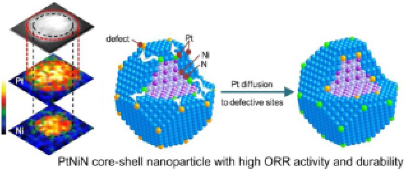- Home
-
Research Groups
Division Groups
- Artificial Photosynthesis
- Catalysis: Reactivity & Structure
- Electrochemical Energy Storage
- Electron- and Photo-Induced Processes for Molecular Energy Conversion
- Neutrino and Nuclear Chemistry
- Surface Electrochemistry and Electrocatalysis
Associated Groups
- Catalysis for Alternative Fuels Production
- Nanostructured Interfaces for Catalysis
- Structure and Dynamics of Applied Nanomaterials
- People
- Operations
- News
- Events

Surface Electrochemistry and Electrocatalysis
New nitride-stabilized core-shell nanoparticles
As briefly mentioned in 6.2.1.2, we found that PtNi nanoparticles can undergo profound structural and chemical changes forming Ni nitride cores and 2-4 monolayer thick Pt shells by annealing in an NH3 gas. The PtNiN catalyst exhibited high mass and specific activities and a very good stability for the ORR. We describe a route to the development of novel PtNiN core shell catalysts with low Pt content shell and inexpensive NiN core having high activity and stability for the oxygen reduction reaction (ORR).

The PtNiN synthesis involves nitriding Ni nanoparticles and simultaneously encapsulating it by 2−4 monolayer-thick Pt shell. The experimental data and the density functional theory calculations indicate nitride has the bifunctional effect that facilitatesformation of the core−shell structures and improves the performance of the Pt shell by inducing both geometric and electronic effects. Synthesis of inexpensive NiN cores opens up possibilities for designing of various transition metal nitride based core−shell nanoparticles for a wide range of applications in energy conversion processes.
Nano Lett. 2012, 12, 6266−6271




